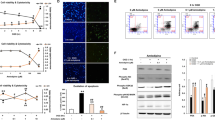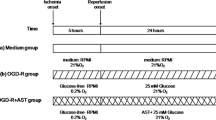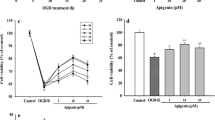Abstract
Deprivation of oxygen and glucose is the main cause of neuronal cell death during cerebral infarction and can result in severe morbidity and mortality. In general, the neuroprotective therapies that are applied after ischemic stroke have been unsuccessful, despite many investigations. Acetyl-L-carnitine (ALCAR) plays an important role in mitochondrial metabolism and in modulating the coenzyme A (CoA)/acyl-CoA ratio. We investigated the protective effects of ALCAR against oxygen-glucose deprivation (OGD) in neural stem cells (NSCs). We measured cell viability, proliferation, apoptosis, and intracellular signaling protein levels after treatment with varying concentrations of ALCAR under OGD for 8 h. ALCAR protected NSCs against OGD by reducing apoptosis and restoring proliferation. Its protective effects are associated with increases in the expression of survival-related proteins, such as phosphorylated Akt (pAkt), phosphorylated glycogen synthase kinase 3b (pGSK3b), B cell lymphoma 2 (Bcl-2), and Ki-67 in NSCs that were injured by OGD. ALCAR also reduced the expression of death-related proteins, such as Bax, cytosolic cytochrome C, cleaved caspase-9, and cleaved caspase-3. We concluded that ALCAR exhibits neuroprotective effects against OGD-induced damage to NSCs by enhancing the expression of survival signals and decreasing that of death signals.





Similar content being viewed by others
References
Goldberg MP, Choi DW (1993) Combined oxygen and glucose deprivation in cortical cell culture: calcium-dependent and calcium-independent mechanisms of neuronal injury. J Neurosci 13:3510–3524
Murray CJ, Lopez AD (1997) Mortality by cause for eight regions of the world: global burden of disease study. Lancet 349:1269–1276
Chen YH, Chiang YH, Ma HI (2014) Analysis of spatial and temporal protein expression in the cerebral cortex after ischemia-reperfusion injury. J Clin Neurol 10:84–93
Deshpande JK, Siesjo BK, Wieloch T (1987) Calcium accumulation and neuronal damage in the rat hippocampus following cerebral ischemia. J Cereb Blood Flow Metab 7:89–95
MacManus JP, Buchan AM, Hill IE, Rasquinha I, Preston E (1993) Global ischemia can cause DNA fragmentation indicative of apoptosis in rat brain. Neurosci Lett 164:89–92
Leist M, Jaattela M (2001) Four deaths and a funeral: from caspases to alternative mechanisms. Nat Rev Mol Cell Biol 2:589–598
Zivin JA (1997) Neuroprotective therapies in stroke. Drugs 54:83–88, discussion 88–89
Flanagan JL, Simmons PA, Vehige J, Willcox MD, Garrett Q (2010) Role of carnitine in disease. Nutr Metab (Lond) 7:30–43
Bahl JJ, Bressler R (1987) The pharmacology of carnitine. Ann Rev Pharmacol Toxicol 27:257–277
Ghelardini CN, Galeotti M, Calvani et al (2002) Acetyl-L-carnitine induces muscarinic antinocieption in mice and rats. Neuropharmacology 43:1180–1187
Lombardo PR, Scuri E, Cataldo et al (2004) Acetyl-Lcarnitine induces a sustained potentiation of the afterhyperpolarization. Neuroscience 128:293–303
Fleury C, Mignotte B, Vayssiere JL (2002) Mitochondrial reactive oxygen species in cell death signaling. Biochimie 84:131–141
Zanelli SA, Solenski NJ, Rosenthal RE, Fiskum G (2005) Mechanisms of ischemic neuroprotection by acetyl-L-carnitine. Ann NY Acad Sci 1053:153–161
Jalal FY, Bohlke M, Maher TJ (2010) Acetyl-L-carnitine reduces the infarct size and striatal glutamate outflow following focal cerebral ischemia in rats. Ann NY Acad Sci 1199:95–104
Jin K, Sun Y, Xie L, Peel A, Mao XO, Batteur S, Greenberg DA (2003) Directed migration of neuronal precursors into the ischemic cerebral cortex and striatum. Mol Cell Neurosci 24:171–189
Chojnacki A, Weiss S (2008) Production of neurons, astrocytes and oligodendrocytes from mammalian CNS stem cells. Nat Protoc 3:935–940
Currle DS, Hu JS, Kolski-Andreaco A, Monuki ES (2007) Culture of mouse neural stem cell precursors. J Vis Exp 2:152
Studer L, Tabar V, McKay RD (1998) Transplantation of expanded mesencephalic precursors leads to recovery in parkinsonian rats. Nat Neurosci 1:290–295
Li C, Issa R, Kumar P, Hampson IN, Lopez-Novoa JM, Bernabeu C, Kumar S (2003) CD105 prevents apoptosis in hypoxic endothelial cells. J Cell Sci 116:2677–2685
Qi J, Hong ZY, Xin H, Zhu YZ (2010) Neuroprotective effects of leonurine on ischemia/reperfusion-induced mitochondrial dysfunctions in rat cerebral cortex. Biol Pharm Bull 33:1958–1964
Pan J, Chang Q, Wang X, Son Y, Zhang Z, Chen G, Luo J, Bi Y et al (2010) Reactive oxygen species-activated Akt/ ASK1/p38 signaling pathway in nickel compound-induced apoptosis in BEAS2B cells. Chem Res Toxicol 23:568–577
Virmani A, Binienda Z (2004) Role of carnitine esters in brain neuropathology. Mol Aspects Med 25:533–549
Virmani MA, Biselli R, Spadoni A, Rossi S, Corsico N, Calvani M, Fattorossi A, De Simone C et al (1995) Protective actions of L-carnitine and acetyl-L-carnitine on the neurotoxicity evoked by mitochondrial uncoupling or inhibitors. Pharmacol Res 32:383–389
Virmani MA, Caso V, Spadoni A, Rossi S, Russo F, Gaetani F (2001) The action of acetyl-Lcarnitine on the neurotoxicity evoked by amyloid fragments and peroxide on primary rat cortical neurones. Ann NY Acad Sci 939:162–178
Zhang R, Zhang H, Zhang Z, Wang T, Niu J, Cui D, Xu S (2012) Neuroprotective effects of pre-treatment with L-carnitine and acetyl-L-carnitine on ischemic injury in vivo and in vitro. Int J Mol Sci 13:2078–90
Yuan J (2009) Neuroprotective strategies targeting apoptotic and necrotic cell death for stroke. Apoptosis 14:469–477
Nakamichi N, Taguchi T, Hosotani H, Wakayama T, Shimizu T, Sagiura T, Iseki S, Kato Y (2012) Functional expression of carnitine/organic cation transpoter OCTN1 in mouse brain neurons: possible involvement in neuronal differentiation. Neurochemistiry Int 61:1121–1132
Ishimoto T, Nakamichi N, Hosotani H, Masuo Y, Sugiura T, Kato Y (2014) Organic cation transporter-mediated ergothioneine uptake in mouse neural progenitor cells suppresses proliferation and promotes differentiation into neurons. Plos ONE 9, e89434
Tamai I, Ohashi R, Nezu J, Yabuuchi H, Oku A, Shimane M, Sai Y, Tsuji A (1998) Molecular and functional identification of sodium ion-dependent, high affinity juman carnitine transporter OCTN2. J Biol Chem 273:20378–20382
Kido Y, Tamai I, Ohnari A, Sai Y, Kagami T, Nezu J, Nikaido H, Hashimoto N et al (2001) Functional relevance of carnitine transporter OCTN2 to brain distribution of L-carnitine and actyl-L-carnitine across the blood–brain barrier. J Neurochem 79:959–969
Park J, Park HH, Choi H, Kim YS, Yu HJ, Lee KY, Lee YJ, Kim SH et al (2012) Coenzyme Q10 protects neural stem cells against hypoxia by enhancing survival signals. Brain Res 1478:64–73
Choi NY, Choi H, Park HH, Lee EH, Yu HJ, Lee KY, Lee YJ, Koh SH (2014) Neuroprotective effects of amlodipine besylate and benidipine hydrochloride on oxidative stress-injured neural stem cells. Brain Res 1551:1–12
Zhao Y, Xiao Z, Gao Y, Chen B, Zhang J, Dai J (2007) Insulin rescues ES cell-derived neural progenitor cells from apoptosis by differential regulation of Akt and ERK pathways. Neurosci Lett 429:49–54
Broughton BR, Reutens DC, Sobey CG (2009) Apoptotic mechanisms after cerebral ischemia. Stroke 40:e331–e339
Chung H, Seo S, Moon M, Park S (2008) Phosphatidylinositol-3-kinase/Akt/glycogensynthasekinase-3 beta and ERK1/2 pathways mediate protective effects of acylated and unacylated ghrelin against oxygen-glucose deprivation-induced apoptosis in primary rat cortical neuronal cells. J Endocrinol 198:511–521
Cantley LC (2002) The phosphoinositide 3-kinase pathway. Science 296:1655–1657
Cantrell DA (2001) Phosphoinositide 3-kinase signalling pathways. J Cell Sci 114:1439–1445
Koh SH, Lo EH (2015) The role of the PI3K pathway in the regeneration of the damaged brain by neural stem cells after cerebral infarction. J Clin Neurol 11:297–304
Pap M, Cooper GM (2002) Role of translation initiation factor 2B in control of cell survival by the phosphatidylinositol 3-kinase/Akt/glycogen synthase kinase 3beta signaling pathway. Mol Cell Biol 22:578–586
Frame S, Cohen P, Biondi RM (2001) A common phosphate binding site explains the unique substrate specificity of GSK3 and its inactivation by phosphorylation. Mol Cell 7:1321–1327
Koh SH, Noh MY, Kim SH (2008) Amyloid-beta-induced neurotoxicity is reduced by inhibition of glycogen synthase kinase-3. Brain Res 1188:254–262
Acknowledgments
This work was supported by a grant from the Korea Research Foundation (2015R1A2A2A04004865) and a grant from the NanoBio R&D Program of the Korea Science and Engineering Foundation, funded by the Ministry of Education, Science and Technology (2007-04717).
Author information
Authors and Affiliations
Corresponding author
Additional information
Seong Wan Bak and Hojin Choi contributed equally to this work.
Rights and permissions
About this article
Cite this article
Bak, S.W., Choi, H., Park, HH. et al. Neuroprotective Effects of Acetyl-L-Carnitine Against Oxygen-Glucose Deprivation-Induced Neural Stem Cell Death. Mol Neurobiol 53, 6644–6652 (2016). https://doi.org/10.1007/s12035-015-9563-x
Received:
Accepted:
Published:
Issue Date:
DOI: https://doi.org/10.1007/s12035-015-9563-x




